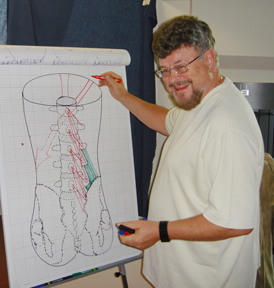Clinical and Scientific Rationale for Modern Manual Therapy (MT1)

Clinical and Scientific Rationale for Modern Manual Therapy (MT1)
The OGI offers an internationally and nationally renowned manual physical therapy curriculum based on innovative and unique concepts. Continuing education courses cover all levels of research in proven concepts and clinical practice derived from the predominant schools of thought in manual therapy, osteopathy, sports medicine, rheumatology, neurology, and radiology. Click on any of the courses listed below for a full description. All courses earn credits toward Certification, Residency, and/or Fellowship Programs.
With its origin in Norwegian Manual Therapy, this course is foundational for all of our manual therapy and exercise courses. Taught and updated since the 1970s, the course was the evidence for manual therapy and exercise before there was Evidence-based medicine. Learn clinical application with a more in-depth application of histology, neurophysiology, traumatology, and work physiology. Apply concepts to what you already do, as well as unique clinical applications that will make a difference in your patient care now. Use science, rather than tradition, to select and dose your manual and exercise interventions.
Course Dates and Cities
An Independent Study format that can be completed in the convenience of the home or office at a reduced cost. The curriculum has the same high standards as the MT-1 on-site seminar. The required final examination covers topics such as functional histology, neurophysiology, the pathophysiology of trauma, stages of healing, exercise physiology, and the scientific rationale behind evaluation and treatment with manual therapy. The MT-1 serves as a prerequisite for MT-2, MT-3, MT-4, and MT-5.
Register for MT1 Home Study here
MT1 Course Material
Access digital course materials in PDF format from any web-enabled device. Hard Copies are available to order for an additional cost.
This course presents clinically relevant research on functional histology, anatomy, neurophysiology, biomechanics, and traumatology. It offers a systematic rationale for evaluation, treatment, and prevention. Course presented through lectures and demonstrations with supporting handouts. List the optimal stimuli for regeneration/repair of neuro-musculoskeletal tissues. Understand and discuss how to apply basic scientific rationale to patient treatment. The MT-1 is recommended as a prerequisite for MT-2, MT-3, MT-5, and the STEP series 1-6.
The OGI offers an internationally and nationally renowned manual physical therapy curriculum based on innovative and unique concepts. Continuing education courses cover all levels of research in proven concepts and clinical practice derived from the predominant schools of thought in manual therapy, osteopathy, sports medicine, rheumatology, neurology, and radiology. Click on any of the courses listed below for a full description. All courses earn credits toward Certification, Residency, and/or Fellowship Programs.
MT-1 Objectives
Improve…
Knowledge of concepts of the injury, cellular fluid pressure changes, protein movements, trauma, pain, infection, immobilization, muscle guarding, decreased joint motion, and edema.
Understand…
Arthrokinematics related to accessory motion, component motion, and joint play.
Discover….
Different methodologies for joint mobilization and manipulation
Application of mechanoreceptor science to treat pain, normalize motor patterns, and improve facilitation.
Grasp…
Rules for concave and convex joint movements.
Starting position, resting position, and closed packed position.
How to apply concepts of the optimal stimuli for regeneration and regeneration of Bone, Collagen, Cartilage, Disc, and muscle
Learn…
The 7 grades of joint mobility.
How to dose exercise specifically for tissue repair, improving local circulation, edema reduction, coordination, endurance, and strength.
Perform…
Basic guidelines for performance of joint mobilization
MT1 Course Schedule
Day 1
8:00 Registration / Welcome
8:30 Biomechanics / evaluation concepts
10:15 Histology: Bone-Disc
12:00 LUNCH
1:00 Histology: Cartilage and Collagen
2:30 BREAK
2:45 Collagen-Scar
4:45 Discussion /Summary
Day 2
8:00 Questions and Answers
8:30 Pain-Neuroanatomy-Nerve Receptors-Symptomatology
9:30 Neurophysiology-Inhibition-Facilitation. Sensory-Motor and Sympathetics
10:45 Group Work on Choices of Articulation
11:15 The Sympathetic System Segmental Facilitation “The Manual Therapy Lesion”
12:00 LUNCH
1:00 Traumatology: Capillary Pressures- Phases of Healing
1:00 Work Physiology: Principles of Overload, Muscle Fibers, Stress Effects, Holten Curve
2:45 Functional Qualities: Length/Tension-Eccentric-Concentric-Speed. Fixation of strength
3:45 Strength-Volume-Exercise and “The Manual Therapy Lesion” Mobilization and Stabilization
4:45 Course Critiques/Certificates
Manual Therapy Seminars
MT-2: Manual Therapy of the Cervical spine, TMJ and Upper Extremity
MT-3: Manual Therapy of the Lumbar Spine, Pelvis and Lower Extremity
MT-5: Clinical Problem Solving
MT-6: Introduction to Spinal Manipulation
MT-7: Dynamic Soft Tissue Mobilization
MT-8: Extremity Joint Manipulation

